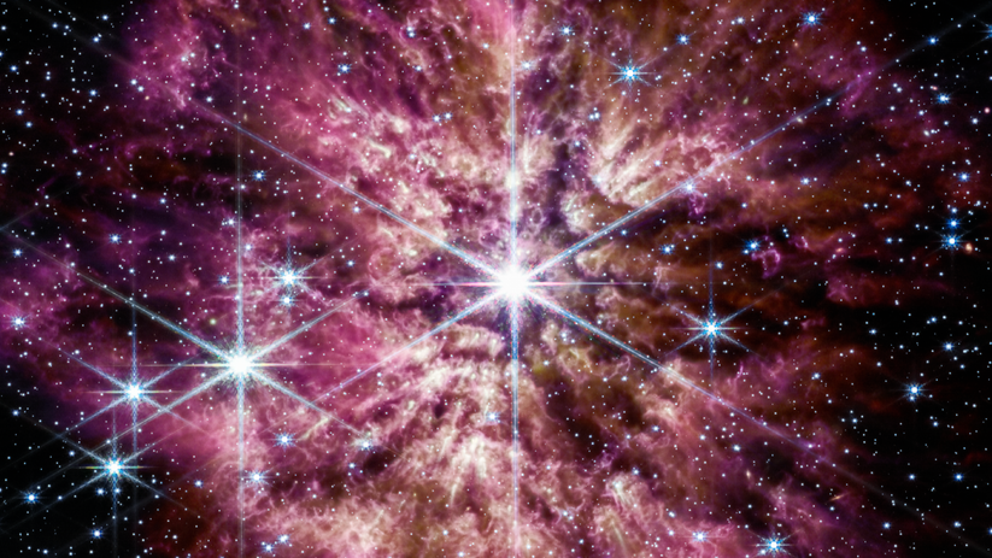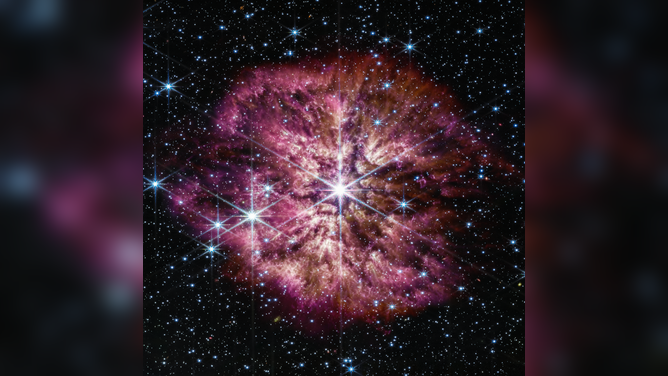James Webb Space Telescope captures rarely seen view of supernova start with explosion of cosmic dust
This massive star is 30 times the sun's mass and is said to have shed 10 suns' worth of material. The gas ejected from WR 124 cools and then forms cosmic dust. The image captured by JWST shows the start to the star explosion.
Rarely seen prelude to supernova captured by James Webb Space Telescope
The luminous, hot star Wolf-Rayet 124 (WR 124) is prominent at the center of the James Webb Space Telescope’s composite image combining near-infrared and mid-infrared wavelengths of light from Webb’s Near-Infrared Camera and Mid-Infrared Instrument.
NASA's James Webb Space Telescope does it again – this time capturing the sights as a star starts to explode.
"The rare sight of a Wolf-Rayet star – among the most luminous, most massive, and most briefly detectable stars known – was one of the first observations made by NASA's James Webb Space Telescope in June 2022," NASA said in a statement. "Webb shows the star, WR 124, in unprecedented detail with its powerful infrared instruments."
The Wolf-Rayet star is said to be 15,000 light-years away and located in the constellation Sagittarius.
"Only some of them go through a brief Wolf-Rayet phase before going supernova, making Webb's detailed observations of this rare phase valuable to astronomers," NASA said.
A supernova is the explosion of a star, and the largest explosion that takes place in space, the space agency said.
This massive star is 30 times the sun's mass and is said to have shed 10 suns' worth of material. The gas ejected from WR 124 cools and then forms cosmic dust. The image captured by JWST shows the infrared light.
Astronomers said that this cosmic dust is essential as it shelters forming stars, gathers together to help form planets, and serves as a platform for molecules to form and clump together.
"Webb opens up new possibilities for studying details in cosmic dust, which is best observed in infrared wavelengths of light," NASA said. "Webb's Near-Infrared Camera (NIRCam) balances the brightness of WR 124's stellar core and the knotty details in the fainter surrounding gas. The telescope's Mid-Infrared Instrument (MIRI) reveals the clumpy structure of the gas and dust nebula of the ejected material now surrounding the star."
JAMES WEBB SPACE TELESCOPE IMAGES WOW BY SHOWING STAR NURSERY, GALAXIES IN A COSMIC DANCE
This JWST image will help astronomers continue to understand a crucial period in the universe's early history.
"Webb's detailed image of WR 124 preserves forever a brief, turbulent time of transformation, and promises future discoveries that will reveal the long-shrouded mysteries of cosmic dust," scientists said.
Incredible images from James Webb show the universe like never before
As the world's premier space science observatory, the James Webb Space Telescope is giving us glimpses into distant worlds like never before.



